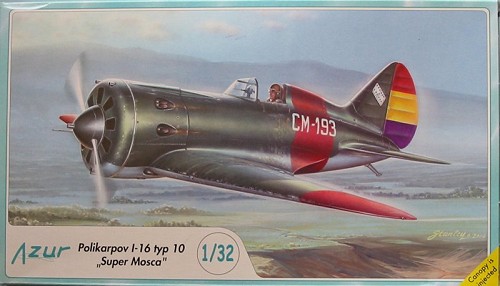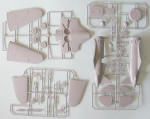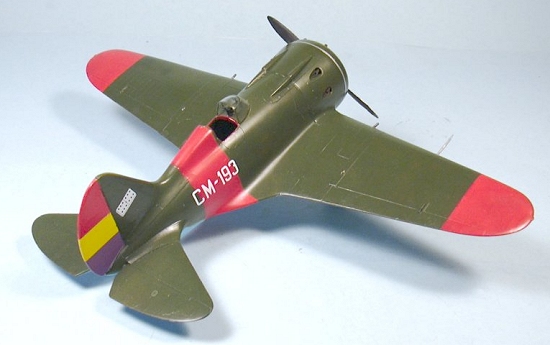
| KIT: | Azur 1/32 Polikarpov I-16 model 10 |
| KIT #: | ? |
| PRICE: | $34.95 MSRP |
| DECALS: | Three options |
| REVIEWER: | Tom Cleaver |
| NOTES: | Short run |

| HISTORY |
Polikarpov’s I-16 was the first low-wing monoplane with enclosed cockpit and retractable landing gear to attain squadron service with any air force, making the little fighter a very significant airplane indeed.
All other designers of the period believed that the cantilever monoplane wing would not withstand the stress of combat maneuvering without a heavy structure, with the result that their monoplanes had fixed gear and bracing struts for a lightweight wing, which just about canceled out any advantage conferred by the monoplane configuration. Designers in Europe and the United States would have been amazed to discover that Nikolai Polikarpov - at the time the leading fighter designer in the Soviet Union - had begun design of what would become the I-16 fighter in 1932, the same year Boeing designed their P-26 with spatted landing gear and wire-braced wing!
The I-16 deserved more credit than it received in the West. It was claimed that the design was inspired by the inferior P-26, despite the fact both had commenced design at almost the same time and the I-16 was under flight test before the first P-26 was delivered to the USAAC - the Spanish fascists called the airplane “the Boeing” when they met it in combat during the Spanish Civil War as a result of this fallacious belief. Built in tens of thousands, the I-16 did more to raise Soviet combat design techniques to world standards than any other type.
By 1936, the production standard I-16 was the Model 10, with an M-25 engine of 700 h.p., the license-built Wright Cyclone, providing a top speed of 282 m.p.h., and armed with 4 7.62mm ShKAS machine guns with 500 rounds per gun.
With the outbreak of Francisco Franco’s fascist rebellion against the Republican Government of Spain in 1936, Stalin decided to arm the Republicans to face the fascist threat. The first I-16s arrived in Barcelona in November 1936and gave the German-manned Condor Legion such a nasty surprise in December when the airplane demonstrated such total supremacy over the He-51 biplane fighter as regarded speed, armament and maneuverability that the German pilots were forbidden to enter combat with I-16s, and the Luftwaffe was forced to send three prototype Bf-109s to Spain to counter the speedy Soviet fighters.
Known as the “Mosca” or “Fly” to the Spanish for its diminutive size, the I-16 was an unforgiving mount. While very maneuverable, it was short-coupled, which made it directionally unstable, and it was wont to snap into a high-speed stall/spin at the slightest provocation if flown with any ham-handedness.
The I-16 equipped three squadrons of Soviet volunteers, whose ranks were expanded with the intake of such volunteers from the International Brigade as Americans “Whitey” Dahl and Ajax Baumler, who had proven their ability flying the I-15 “Chato” against the fascists and becoming the first American aces of what would become the Second World War.
Unfortunately for the Soviet Union, the I-16, which was very competitive with the early Jumo-powered Bf-109s had reached the apex of its design curve at the point where the Bf-109 went on to true greatness with a Daimler-Benz powerplant, and the airplane - which was the main fighter type in the Red Air Force at the time of the German invasion in 1941 - was thoroughly overmatched by the Bf-109E and Bf-109F models it faced.
| THE KIT |
 I-16 kits have been few and far between, with accuracy varying from “not
much” to “sort of,” with the exception of the very accurate I-16 released
in 1989 as a vacuform by MPM. Thus, it is not surprising that this 1/32
I-16 - the first kit of this airplane in this scale that I am aware of -
would come from MPM by way of their Azur imprint, and would be the
most-accurate I-16 out of the box I have yet found. The only inaccuracy I
found in the kit was on the box-top, where it was called a “Super-Mosca,” a
term that did not apply to the Model 10, which is certainly a small bone to
pick indeed.
I-16 kits have been few and far between, with accuracy varying from “not
much” to “sort of,” with the exception of the very accurate I-16 released
in 1989 as a vacuform by MPM. Thus, it is not surprising that this 1/32
I-16 - the first kit of this airplane in this scale that I am aware of -
would come from MPM by way of their Azur imprint, and would be the
most-accurate I-16 out of the box I have yet found. The only inaccuracy I
found in the kit was on the box-top, where it was called a “Super-Mosca,” a
term that did not apply to the Model 10, which is certainly a small bone to
pick indeed.
The original airplane was simple and so is this kit. Fabric effect on
wings and tail surfaces is petite and looks like what a fabric-covered
flying surface actually looks like. The cockpit is sparsely-detailed, just
as was the original.  The
injection-molded windscreen, which is a bit like a “coke-bottle” in terms
of clarity, is as accurate as its original was.
The
injection-molded windscreen, which is a bit like a “coke-bottle” in terms
of clarity, is as accurate as its original was.
The kit is obviously “limited run” with thick sprue gates requiring that the modeler carefully cut the parts off and clean them up. I can report, having assembled the wing, that once the parts are cleaned up they fit together well, and will require nothing more than Mr. Surfacer 500 to take care of any gaps or seams. Unfortunately, the kit does not provide an engine, though fortunately there are 1/32 scale Cyclones available from aftermarket sources for those who want to open up the cooling vents on the front of the cowling.
Decals are provided for two aircraft flown by Soviet volunteers in the 1st and 3rd Escuadrillas de Moscas of the Spanish Republican Air Force in 1937, and one I-16 captured and flown by Spanish Falangist forces in the same year.
| CONCLUSIONS |
A simple yet accurate kit of an historically-important warplane. Definitely a nice addition to the growing number of decent kits in this larger scale, and one that provides the basis for a super-detailed model for any modeler who has desire.
Review kit courtesy of Hannants.
If you would like your product reviewed fairly and quickly by a site that has nearly 300,000 visitors a month, please contact me or see other details in the Note to Contributors.